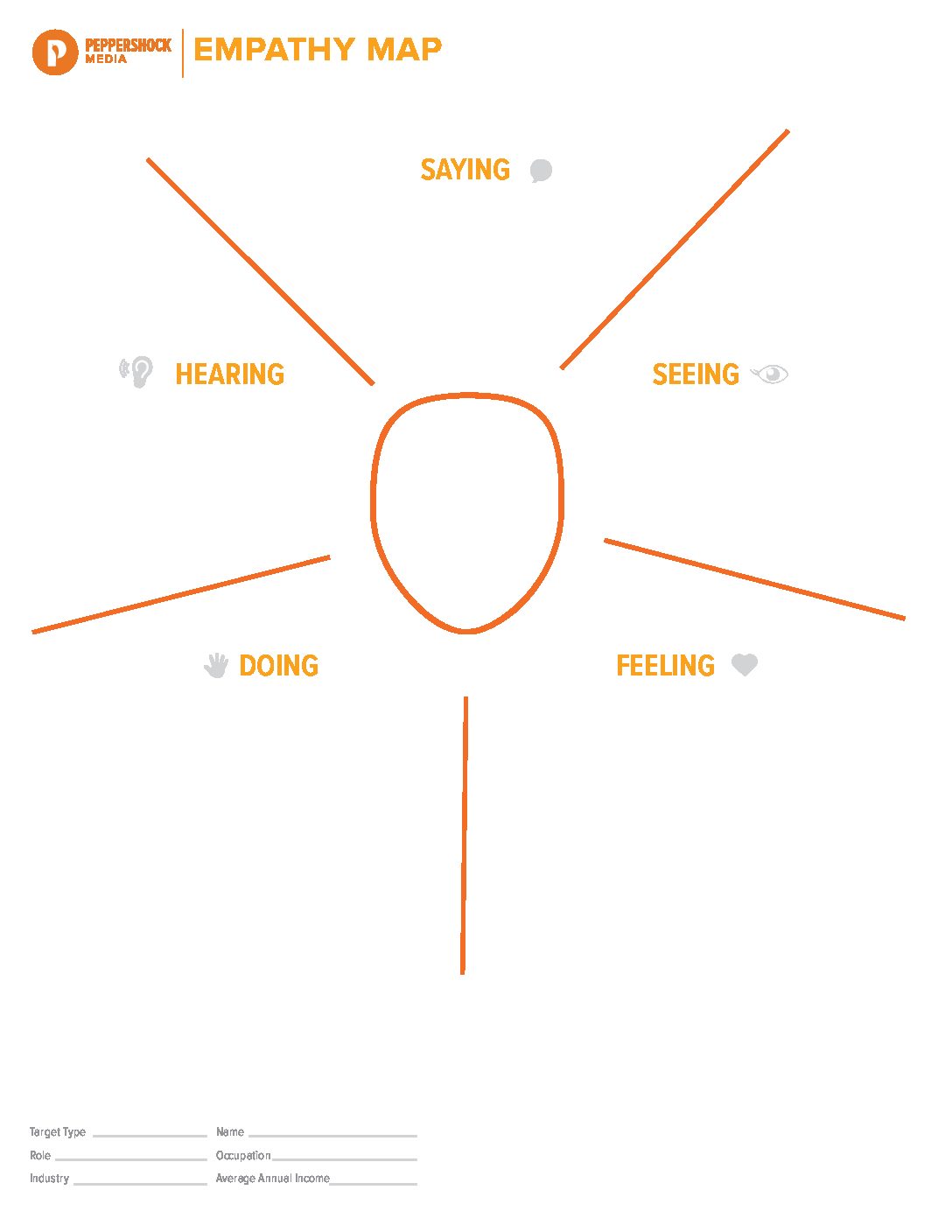Empathy mapping is a highly effective tool we here at Peppershock Media use in our marketing audit process. It’s a simple, fun activity that is key to figuring out who your target audience is and how exactly you can reach them effectively.
The premise of our empathy mapping exercise is that we create a persona or often multiple personas by identifying various traits and characteristics as well as psychographic and demographic information of the most ideal customer profiles. Once we create this character (always remember to give them a name) we then move on to what this person is hearing, seeing, feeling, saying, and doing. Brainstorming this information, no matter how odd or irrelevant the detail may sound, is crucial to stepping into the shoes of who it is we as marketers want to reach.

Things to learn from each category:
Demographics – This section is important for learning the basics about the persona you have created. It is where you would include things like gender, age, job, salary, and anything else you think may be relevant to know about this character. You may think some of this may be unnecessary because every target is different. Yet what you will find is that many members of your main target audience are often quite similar. Knowing what it is your target does for a living, for example, can help you figure out how you want to market to them in terms of what information appeals best to them and how it is you can sell them on their needs.
Hearing – What is this person you are trying to reach hearing? This can be anything from what their employees are saying to them, what they are hearing within the industry, or even whether or not they’re listening to certain radio stations or podcasts during their daily commute. Influence from others plays a major role in determining what your target is seeking. When respected members of an industry have something to say, others listen, and when employees have concerns or requests, we hope that an employer would take their words into consideration. Because of this, sometimes you need to appeal to your target’s circle of influence as well as the target themselves.
Seeing – Part of seeing has to do with your typical idea of advertising. These questions can include: what are they watching on tv or reading, or what social media are they often on? Obviously, there are tons more questions that can be asked, and I urge you to do so. This, however, isn’t the only aspect of seeing. Seeing can also pertain to what it is your target is seeing in their industry in regards to trends, technologies, competition, etc. Learning about the wants and needs of your target is not easy to do if you don’t look at the world through their eyes.
Feeling – It’s called an empathy map, remember? Thinking about what your target is feeling is a chance to truly dive into the wants and needs of your target. Are they stressed about something? Overwhelmed in an aspect of their business? Unresponsive to certain types of marketing? All of these questions are important steps in zoning in on how it is we can reach that target.
Saying – What is this target saying to their team? What questions is he or she asking? Knowing the actual thoughts and opinions of your target plays a big role in figuring out how to market to them. This section ties into some of the other sections such as feeling while diving specifically into the concrete evidence your company has heard from similar clients in the past.
Doing – What your target is doing often ties directly into where and how it is you will advertise to them. Say your target likes to golf or attends seminars and professional events, then you now know where your advertisement may get the most traffic. Figuring out the answer to where a good majority of your main target market may go can make your strategic advertising placement more effective and essentially mean a bigger bang for your buck.
All of these aspects of your target’s life tie in together to map out where, when, why, and how you should market your own business to that target market. Essentially empathy mapping is a brainstorming activity that dumps out a wide variety of information, much of which you likely thought was useless, and turns it into fantastic fresh ideas for your marketing plan!
Down the road as a part of our marketing needs assessment, we will even interview current customers who closely match the profile or persona we have created in order to verify and validate the assumptions we created. This helps us to gain further insight into our target audience by fully understanding the psyche of real-life subjects. This first step of our marketing needs assessment results in a complete collaborative marketing strategy, plan, suggested budget, and timeframe.
When using an empathy map there are things you should remember.
- Get creative – No matter how wacky an idea may seem, it could be important to reaching your target.
- There are no wrong answers – Just throw it out there, anything you can think of. The only answer that doesn’t help is no answer!
- Create more than one empathy map – Almost all businesses have more than one target audience. Making multiple empathy maps can help you cover a wider variety of potential clients you want to reach.
- Step into your characters shoes – Don’t approach this from your own perspective. Instead, take what you have learned from experience and think about things from the other side of the desk.
 We here at Peppershock have gone through this process time and time again. If you want to learn more about empathy mapping or our marketing audit process we would love to help! Our professionals can pinpoint that target, research them, and strategize how to market to them as we have successfully done many times before. To get started with a marketing audit or learn more click here.
We here at Peppershock have gone through this process time and time again. If you want to learn more about empathy mapping or our marketing audit process we would love to help! Our professionals can pinpoint that target, research them, and strategize how to market to them as we have successfully done many times before. To get started with a marketing audit or learn more click here.





